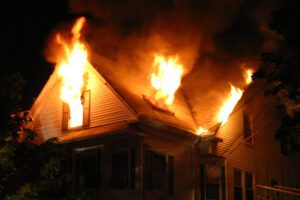Dealing with fire damage can be one of the most traumatic experiences a person can face. Not only do you have to cope with the loss of property and belongings, but navigating the murky waters of insurance claims can be equally daunting. If your home has suffered fire damage, you may find yourself frustrated and overwhelmed with the next steps.
If you want to avoid the stress and confusion that often comes with handling a claim on your own, skip to the bottom of this guide to find out the easy way to handle your fire damage claim. Otherwise, keep reading.
This essential guide aims to provide you with clarity on how to effectively navigate fire damage claims with your insurance, especially after your claim has been denied or underpaid.
Understanding Your Fire Insurance Policy
The first step in navigating a fire damage insurance claim is understanding your insurance policy. Many homeowners are under the impression that their policy will cover all types of fire damage, but that is not always the case. Here are some critical topics to consider regarding your policy:
1. Types of Fire Damage Coverage

Insurance policies typically fall into two categories concerning fire damage:
Actual Cash Value (ACV): This covers the replacement cost of your property minus depreciation. If your furniture is worth $1,000 and has experienced depreciation of 30%, your claim would only yield $700.
Replacement Cost Value (RCV): Under this type of policy, your claim will cover the cost of replacing your damaged items without factoring in depreciation. For example, if your chair costs $1,000 to replace today, you would receive that full amount.
Before filing your claim, it’s imperative to identify which type of coverage your policy offers.
2. Exclusions
Always review your insurance policy for exclusions related to fire damage. Common exclusions can include acts of arson, certain natural disasters, and damage due to neglect. Understanding these exclusions can help you gauge how likely a claim will be accepted.
3. Limits of Fire Damage Coverage
Every insurance policy has limits, meaning they specify a maximum payout for different categories of coverage. Make sure you know these limits so you can set your expectations accordingly.
Steps to Take After a Fire
Once you’ve dealt with the immediate concerns of safety and shelter, you can begin the process of filing a claim. Here’s a step-by-step guide on what you should do:
Report the Fire Damage to Your Insurance Company
Contact your agent or insurer as soon as possible. Prompt communication is crucial in ensuring that your claim moves through the system efficiently. Most insurance companies have a specific timeframe within which you must report the incident.Document Everything
To strengthen your claim, thoroughly document the damage. Take photographs or videos of the aftermath and make a detailed list of all affected items, including receipts where possible. This documentation will be invaluable when substantiating your claim.Secure Your Property
Make efforts to prevent further damage to your property. This may include boarding up windows, covering holes in the roof, or hiring an emergency mitigation service to ensure your home is protected. Keep all receipts for these expenditures, as they may be reimbursable under your policy.File Your Fire Damage Claim
Submit your documentation and details to your insurance company as soon as possible. Ensure you keep copies of everything you send.Monitor the Progress
Regularly check in on your claim through your insurer’s online portal or by speaking directly with your insurance agent. The claims process can often be slow, and persistence can help ensure your claim is prioritized.
Understanding Fire Claim Denials and Underpayments
Even with careful preparation, it’s not uncommon for insurance claims to be denied or underpaid. If you find yourself in this frustrating situation, you’re not alone. Every fire damage claim will be underpaid or denied the first time. It's just how the insurance companies work. Here are some common reasons they will use for denials or underpayments:

Lack of Documentation
Insurance companies often look for detailed documentation to substantiate a claim. Failing to provide adequate proof of loss can lead to denials.
Exceeding Coverage Limits
Your claim could be denied if the total damages exceed your policy’s coverage limits. Always make sure you understand these limits from the outset.
Inaccurate Claims
Errors in the claim submission could lead to inaccuracies that are grounds for denial.
Perceived Negligence
If the insurance company interprets your actions as negligent (e.g., if they believe the fire was preventable), they may deny your claim.
If your claim is denied or if you receive a payout that is less than what you believe is fair, follow these steps:
- Review the Denial Letter
Insurance companies are required to provide you with a reason for your denied claim. Carefully review this letter to understand the rationale behind their decision. - Communicate with Your Adjuster
Your insurance adjuster can provide clarity on the decision. Engage with them to better understand the claims process and address any concerns. - Appeal the Decision
If you believe your claim was unjustly denied or underpaid, you have the right to appeal. Include your documentation, relevant proof of loss, and a letter stating why you believe the claim should be reconsidered.
Hire A Public Adjuster To Fight Your Fire Damage Claim
Dealing with the aftermath of a fire can be overwhelming, and navigating the complex insurance claim process only adds to the burden. By hiring a public adjuster, you gain a dedicated advocate who will work on your behalf to thoroughly assess the damage, negotiate with the insurance company, and ensure you receive the full compensation you're entitled to. Let a public adjuster handle the complexities, so you can focus on rebuilding and moving forward.
